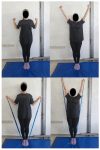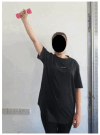Effect of Postural Stabilization Exercises in Combination with Cervical Stabilization Exercises on Craniovertebral Angle, Pain, Disability, and Quality of Life in Patients with Chronic Neck Pain: A Randomized Controlled Trial
- PMID: 40565415
- PMCID: PMC12193335
- DOI: 10.3390/healthcare13121388
Effect of Postural Stabilization Exercises in Combination with Cervical Stabilization Exercises on Craniovertebral Angle, Pain, Disability, and Quality of Life in Patients with Chronic Neck Pain: A Randomized Controlled Trial
Abstract
Objective: The aim of the study was to evaluate the effect of postural stabilization exercises, in addition to cervical stabilization (CS), on the craniovertebral angle (CVA), pain, neck disability index (NDI), and quality of life in people with chronic neck pain. Methods: This study was performed on 60 women with chronic neck pain, aged 20-60 years, who were randomly divided into two groups. Individuals in the first group underwent CS exercises, in addition to scapular and lumbopelvic stabilization (SLPS) exercises, three times a week for 6 weeks. The individuals in the second group underwent only CS exercises for the same period. Moreover, stretching exercises and a 20 min hot pack were applied to the muscles around the neck of all patients. The CVA was measured using photogrammetry. The visual analog scale (VAS) was used to assess pain. The disability level was measured using the NDI. The Turkish version of the 36-Item Short-Form Health Survey (SF-36) was used to assess quality of life. The assessments were conducted before treatment, after treatment, and at the 2-month follow-up. To assess changes over time and between groups, a two-way repeated measures analysis of variance (ANOVA) was conducted. Results: Post-treatment measurements revealed significant differences favoring the SLPS group. The VAS and NDI scores were markedly lower in the SLPS group than in the CS group, both post-treatment (p < 0.001) and at follow-up (p < 0.001). The CVA was significantly greater in the SLPS group at both the post-treatment (p < 0.001) and follow-up (p < 0.001) assessments. However, in all sub-parameters except the SF-36 general health subscale, the SLPS group reported higher scores than the CS group post-treatment and at follow-up. Effect sizes for between-group comparisons ranged from moderate to very large (Cohen's d = 0.65 to 2.31), and partial eta-squared (η2) values indicated moderate to large effect magnitudes (η2 = 0.09 to 0.48), supporting the clinical relevance of the findings. Conclusion: In individuals with neck pain, including SLPS exercises in the treatment program, rather than just exercises for the cervical region, provides more positive results in terms of reducing disability and pain and increasing functionality. Clinical Trial Registration Number: NCT06578481.
Keywords: chronic neck pain; craniovertebral angle; lumbopelvic muscle exercises; postural stabilization; scapular stabilization.
Conflict of interest statement
The authors declare no conflicts of interest.
Figures





Similar articles
-
Internet-Based Telerehabilitation Versus in-Person Therapeutic Exercises in Young Adult Females With Chronic Neck Pain and Forward Head Posture: Randomized Controlled Trial.JMIR Rehabil Assist Technol. 2025 Jul 25;12:e74979. doi: 10.2196/74979. JMIR Rehabil Assist Technol. 2025. PMID: 40712139 Free PMC article.
-
Neuromuscular electrical stimulation (NMES) for patellofemoral pain syndrome.Cochrane Database Syst Rev. 2017 Dec 12;12(12):CD011289. doi: 10.1002/14651858.CD011289.pub2. Cochrane Database Syst Rev. 2017. PMID: 29231243 Free PMC article.
-
Botulinum toxins for the prevention of migraine in adults.Cochrane Database Syst Rev. 2018 Jun 25;6(6):CD011616. doi: 10.1002/14651858.CD011616.pub2. Cochrane Database Syst Rev. 2018. PMID: 29939406 Free PMC article.
-
Systemic pharmacological treatments for chronic plaque psoriasis: a network meta-analysis.Cochrane Database Syst Rev. 2017 Dec 22;12(12):CD011535. doi: 10.1002/14651858.CD011535.pub2. Cochrane Database Syst Rev. 2017. Update in: Cochrane Database Syst Rev. 2020 Jan 9;1:CD011535. doi: 10.1002/14651858.CD011535.pub3. PMID: 29271481 Free PMC article. Updated.
-
Botulinum toxin type B for cervical dystonia.Cochrane Database Syst Rev. 2005 Jan 25;(1):CD004315. doi: 10.1002/14651858.CD004315.pub2. Cochrane Database Syst Rev. 2005. Update in: Cochrane Database Syst Rev. 2016 May 13;(5):CD004315. doi: 10.1002/14651858.CD004315.pub3. PMID: 15674941 Updated.
References
Associated data
LinkOut - more resources
Full Text Sources
Medical

